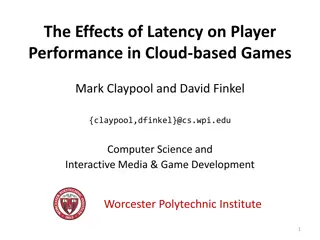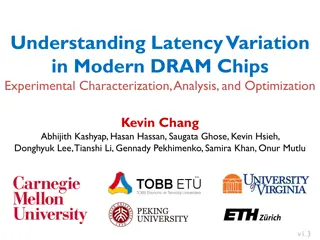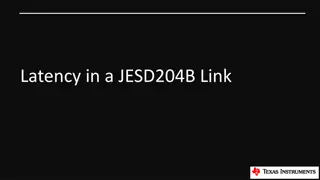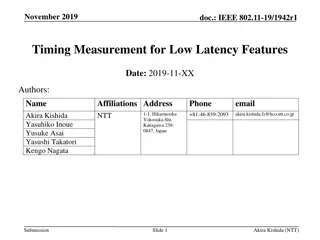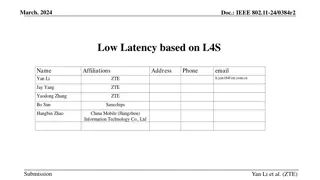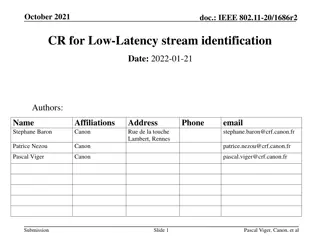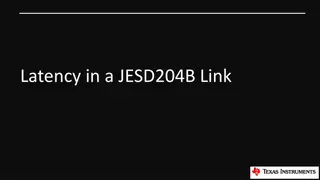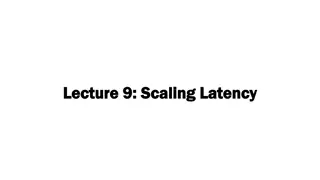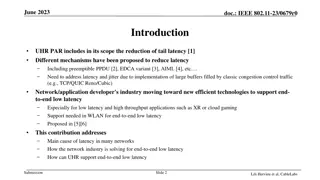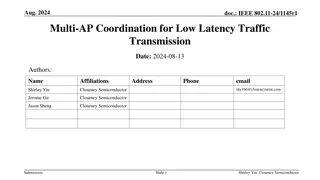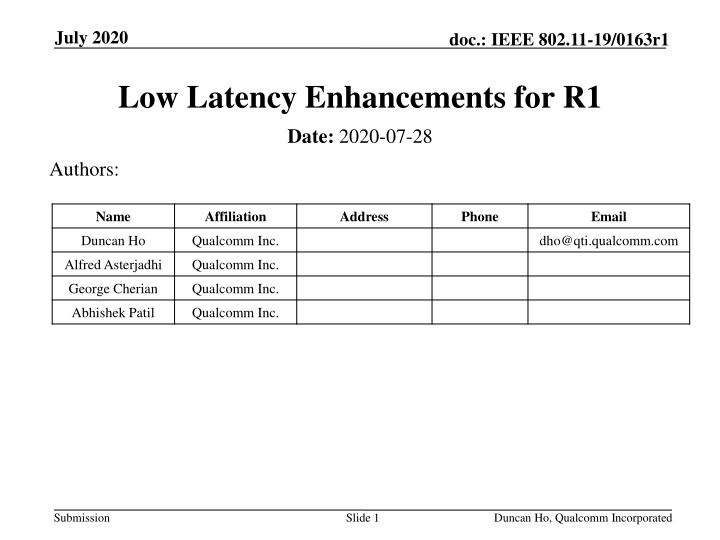
Enhancements for Low Latency in IEEE 802.11 - July 2020 Document
Explore the latest low latency enhancements proposed in the IEEE 802.11 document for various application categories with different latency requirements. The document covers techniques, proposals, and achievable approaches for improving latency in wireless communication systems.
Download Presentation

Please find below an Image/Link to download the presentation.
The content on the website is provided AS IS for your information and personal use only. It may not be sold, licensed, or shared on other websites without obtaining consent from the author. If you encounter any issues during the download, it is possible that the publisher has removed the file from their server.
You are allowed to download the files provided on this website for personal or commercial use, subject to the condition that they are used lawfully. All files are the property of their respective owners.
The content on the website is provided AS IS for your information and personal use only. It may not be sold, licensed, or shared on other websites without obtaining consent from the author.
E N D
Presentation Transcript
July 2020 doc.: IEEE 802.11-19/0163r1 Low Latency Enhancements for R1 Date: 2020-07-28 Authors: Name Affiliation Address Phone Email Duncan Ho Qualcomm Inc. dho@qti.qualcomm.com Alfred Asterjadhi Qualcomm Inc. George Cherian Qualcomm Inc. Abhishek Patil Qualcomm Inc. Submission Slide 1 Duncan Ho, Qualcomm Incorporated
doc.: IEEE 802.11-19/0163r1 Background QoS Requirements of Low-Latency Applications Three main latency regions (categories) are identified for low latency applications A. 10~50ms E.g., interactive video, automated vehicles (per IEEE802.11 Real-time application TIG report) Data Rate Category B AR/VR, remote HMI, hard-real- time cyclic control, machine tools, production lines Category A Interactive video, soft-real-time control, mobile robotics, Automated guided vehicles Category C Hard real-time isochronous control, motion control, printing, packaging 1Gbps B. 1~10ms E.g., AR/VR, gaming AR/VR 100Mbps C. 1ms or less E.g., TSN-like applications 10Mbps Real-time gaming 1Mbps Category C Category B Category A New emerging cases (e.g., AR/VR) fall into Category B Latency 1ms 10ms 50ms 100ms Submission Slide 2 Duncan Ho, Qualcomm Incorporated
doc.: IEEE 802.11-19/0163r1 Background Various low latency enhancement proposals have been presented in TGbe Categories: Techniques/mechanisms to improve latency in the MAC [1][2] Signaling to convey traffic pattern and QoS demands from non-AP to AP [2] Latency measurements and reports [3][4][5] Admission control [6] Submission
doc.: IEEE 802.11-19/0163r1 Proposed Techniques in IEEE Summary of techniques/proposals: Link-domain/Frequency-domain MLO multi-primary contention and tput aggregation TID-to-link mapping confines less well-behaving or best effort traffic within certain link(s) and reserve other links for low latency apps Multiple-channels within a band. EDCA per channel [7] Time-domain Separate queue at the transmitter that has preferential treatment w.r.t other traffic (intra-MLD) [2] New TIDs to indicate low latency traffic (intra-MLD) [2] Prioritized EDCA (both intra-BSS and inter-MLD) [1] TXOP sharing (given by non-AP to AP) [8], CAP (inter-MLD) TSN (both intra-MLD and inter-MLD) [9] The goal of this contribution: Provides a low-latency frame-work for R1, which can be extended for R2 Submission
doc.: IEEE 802.11-19/0163r1 Achievable Approach in R1 One way to achieve tighter, more predictable latency bound is to use AP Scheduling (what 11ax supports and promotes) combined with MLO Step 1: STA indicates its traffic pattern and QoS demand to the AP Step 2: AP accepts/rejects per the current condition of the network Step 3: If accepted, AP guarantees QoS for the STA using different techniques (e.g., put STA on diff links/MLO/TWT/use currently defined EDCA settings, and any combos etc.) What s needed? A STA needs to know if an AP offers this type of low-lat service (AP capability) so the STA can request Some way for the STA to indicate the traffic pattern and QoS demand (e.g., using MSCS, TCLAS, TSPEC, etc) What links the STA prefers (e.g., local co-existence or power save may impact a STA s preference) Main Considerations in this proposal How to ensure the medium is not occupied by other STAs (e.g., OBSS) Can confine 11ax STAs/non-real-time traffic to 2.4 and 5GHz and dedicate 6GHz for low-lat. Still probabilistic in an environment with OBSS but green field 6GHz should be good for some time assuming AP avoids busy 6GHz channels and pick a free 6GHz channel. Limit to a single BSS optimization in R1 Submission
doc.: IEEE 802.11-19/0163r1 What s Needed for R1 (low hanging fruits) Starting point: 11be already provides MLO. Add the following to enhance low latency support in 11be: A way for an AP to advertise its low latency service capability A way for a STA to indicate its traffic pattern and QoS demand Indicates period, actual data arrival offset, avg data rate, delay bound, etc. E.g., Can use TSPEC, TCLA, MSCS or have a more customized version for low-lat A way for the AP to redirect the less-latency sensitive traffic (e.g., best-effort/high- volume) on one link to reduce their impact on the low latency traffic Allow TID-to-link mapping to confine a TID on a set of specific link(s) We have a separation contribution on this to allow negotiation to converge Restrict TIDs of BE/high-volume to some links and map low latency TID to other link(s) Some latency measurement reports from the AP (SP already passed in [4]) User scheduling within 6GHz using 11ax defined TWT with a minor rule change Use TWT framework with stricter access requirements. Broadcast or Individual TWTs is TBD Submission
doc.: IEEE 802.11-19/0163r1 Things to Consider for R2 CAP For individual AP MLD TWT sessions co-ordination TSN support Enhanced reliability Submission
doc.: IEEE 802.11-19/0163r1 SP1 Do you agree to add to the TGbe SFD: An AP MLD shall be able to advertise in its capability that it is latency- aware for a non-AP MLD to request QoS treatment A non-AP MLD may indicate its traffic demand of a specific flow to an AP MLD that is capable TBD what mechanism to use (e.g., TSPEC, TCLA, MSCS or have a more customized version for low-lat) Submission
doc.: IEEE 802.11-19/0163r1 SP2 Do you agree to add to the TGbe SFD: Allow TID-to-link mapping to confine a TID to a subset of the setup links following the TID link mapping Submission
doc.: IEEE 802.11-19/0163r1 SP3 Do you agree to add to the TGbe SFD: Allow the use of the existing TID values (0-7) for any traffic Allow any TID to map to any AC (mechanism TBD) Submission
doc.: IEEE 802.11-19/0163r1 Reference [1]: 11-20/697: Supporting latency-sensitive applications in 11be (Chunyu Hu, Facebook/NTT/LGE/Tencent) [2]: 11-20/418: Low latency service in 802.11be (Dave Cavalcanti, Intel) [3]: 11-20/003: Discussion on latency metric (Suhwook Kim, LG) [4]: 11-20/105: Link Latency Statistics of Multi-band Operations in EHT (Frank Hsu, Mediatek) [5]: 11-20/484: Latency Measurement for Low Latency Applications (Liuming Lu, ZTE Corporation) [6]: 11-19/1615: Multi-band/Multi-channel Operation for Low Latency and Jitter (Liuming Lu, ZTE Corporation) [7]: 11-20/093: Multi-Link for Low Latency (Adrian Garcia-Rodriguez, Nokia) [8]: 11-20/005: Proposals on Latency Reduction (Shubhodeep Adhikari, Broadcom) [9]: 11-19/1287: TSN support in 802.11 and potential extensions for TGbe (Dave Cavalcanti, Intel) Submission Slide 11 Duncan Ho, Qualcomm Incorporated





